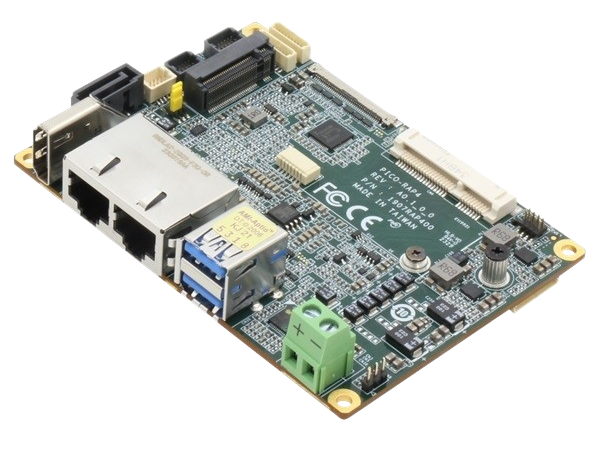
AAEON was tasked with supplying a solution capable of upgrading a client’s service robot line to enable it to autonomously complete a range of complex tasks with speed and precision. While solutions like robotic arms have become common in manufacturing, they are typically used for specific, repetitive, one-dimensional tasks. In contrast, the customer aimed to develop a more dynamic, multifaceted option resembling a humanoid service robot rather than static robotic machinery.
Given this lofty goal, it was important that AAEON presented a compact product combining reliable hardware and the tools to support both the advanced computing and AI inference capability required for such an application. The solution that best fit these needs was the PICO-RAP4, which leverages 13th Generation Intel® Core™ Processing on the compact 100mm x 72mm PICO-ITX form factor.




Developing an advanced autonomous service robot required a powerful, yet energy-efficient platform. Since the robot would need to execute tasks based on complex algorithms in real-time, it would require substantial processing power. Additionally, the solution would need a method to translate and execute the client’s AI inference models, which would guide its actions in practice.
A second, more practical consideration was how the robot would obtain the data analyzed by the client’s inference models. This was crucial because the quality of this data would directly influence the robot’s decision-making process, affecting the accuracy of its object recognition output and the speed of its decision-making. It was essential that the selected solution be equipped with high-speed interfaces for the installation of cameras and sensors.
Finally, the solution would need to be capable of acting as the control center of the robot. Therefore, it would need to have protocols in place to communicate commands to the robot’s hardware and ensure they are executed promptly and accurately.

Deployment scenarios for the robot were relatively broad, with a range of vertical markets being potential beneficiaries. Tasks such as product assembly in the manufacturing industry, crop management in the agricultural sector, and automated catering in the hospitality sphere could be outsourced to the robot in question. As such, the PICO-RAP4's all-round quality made it an excellent fit to power the robot.
To run the AI inference models required to act autonomously, the robot relied on the PICO-RAP4's embedded Intel® Core™ i7-1370PE CPU, which offered 6 performance-cores, 8 efficient-cores and 20 threads to provide extremely high processing power and CPU frequencies capable of handling demanding AI tasks. It also maintained power efficiency through its efficient cores for background operations. While not the primary source of the robot’s AI functionality, the PICO-RAP4's CPU also incorporated several advanced technologies, including Intel® Deep Learning Boost, Intel® Gaussian & Neural Accelerator, and Intel® AVX2, which were instrumental in accelerating AI workloads and enhancing machine learning performance.
To manage the majority of the application’s AI workload, the PICO-RAP4's M.2 2280 M-Key slot, which supported a PCIe 4.0 x4 interface, was equipped with a high-spec AI acceleration module. The PICO-RAP4’s high-bandwidth PCIe interface allowed the AI acceleration module to process the client’s diverse image recognition, natural language processing, and decision-making algorithms without any latency.
The PICO-RAP4's FPC connector allowed for MIPI camera integration, along with two high-definition cameras connected via its USB 3.2 Gen 2 ports to capture multiple sources of visual data, supported by Intel® UHD Graphics. Additionally, the board’s two serial ports provided RS-232/422/485 signal interfaces for connecting GPS modules and environmental sensors.
The robot's control function was determined by the interaction of its GPIO with actuators and motors. To ensure positional accuracy and navigation, accelerometers, gyroscopes, and temperature sensors were supported by its I2C. Additionally, all serial communication on the board benefited from data encryption provided by its onboard TPM 2.0.
Additionally, the PICO-RAP4 enabled the robot to maintain fast and reliable connectivity to other devices through its dual two LAN ports, which supported Intel® Ethernet Controller I226-V and Intel® Ethernet Connection I219-LM technologies at 2.5GbE and 1GbE speeds, respectively. This array of peripheral devices facilitated autonomous navigation in accordance with the robot's surroundings, relying on the instructions transmitted from its inference algorithms. This method of communication also leveraged improved data security, thanks to the onboard TPM 2.0.
An often-overlooked area of autonomous robotics is the capability to achieve reactivity to environmental sounds. Through its full-function audio header (including line-in, line-out, and mic), the PICO-RAP4 enhanced the robot’s situational awareness, enabled it to understand spoken commands and provide alerts in the event it encountered issues.
Thanks to the PICO-RAP4, AAEON’s client was able to develop a fully automated service robot that could be deployed in various settings across industries ranging from retail to agriculture. With an exceptional CPU base, processing the data obtained from the board’s versatile and numerous peripheral devices came with minimal latency. This computational robustness also assisted in providing the power needed to maximize the effectiveness of its AI acceleration module, creating a loop designed for enhanced AI algorithm handling.
The board’s support for both MIPI and USB cameras helped the robot perform tasks with greater accuracy, given the quality of information fed into its AI algorithms was more reliable. Further, full audio with line-in/line-out/mic function further diversified the robot’s capabilities, making it able to process audio commands, while leveraging its outstanding computing power to improve user experiences through machine learning.
Lastly, it is important to note that despite its incredibly lightweight and small size, the PICO-RAP4 offered a plethora of interfaces through which different sensor types could be accommodated without affecting signal quality. The PICO-RAP4 proved to be a powerful yet efficient solution for the client, instrumental in pushing the boundaries of how advanced autonomous robots can become. This case illustrates that as the field of robotics evolves, AAEON will be at the forefront.
